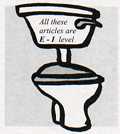
WHERE DOES IT COME FROM?
|
|
|
|||
 THE
TOILET In 1833 the Carnot Institute in Paris presented an anonymous
invention called the 'toilet bowl'. The design was similar to what we sit on
nowadays and was made from metal with a wooden lid*. However it was not a
success until 1886 when the English inventor Thomas Crapper installed a deposit
of water above the toilet that permitted the contents of the bowl to be emptied
automatically. The world finally had its 'water closet'. THE
TOILET In 1833 the Carnot Institute in Paris presented an anonymous
invention called the 'toilet bowl'. The design was similar to what we sit on
nowadays and was made from metal with a wooden lid*. However it was not a
success until 1886 when the English inventor Thomas Crapper installed a deposit
of water above the toilet that permitted the contents of the bowl to be emptied
automatically. The world finally had its 'water closet'. |
THE BIKINI  For many
years women's swimming costumes had experienced a gradual tendency to show more
and more of the bather's* body until in 1946 the French designer Louis Read had
the courage to cut the traditional design in two, His new, two piece, costume
would revolutionise fashion but for the moment it had no name. Just before the
official presentation, the United States started it first peace-time nuclear
tests on the Pacific island of Bikini. Read grasped* the opportunity to
capitalise on the international media coverage of the event to name his
explosive invention the 'bikini'. For many
years women's swimming costumes had experienced a gradual tendency to show more
and more of the bather's* body until in 1946 the French designer Louis Read had
the courage to cut the traditional design in two, His new, two piece, costume
would revolutionise fashion but for the moment it had no name. Just before the
official presentation, the United States started it first peace-time nuclear
tests on the Pacific island of Bikini. Read grasped* the opportunity to
capitalise on the international media coverage of the event to name his
explosive invention the 'bikini'. |
THE BICYCLE This might seem incredible but on the Luxor obelix in Paris (taken from Egypt by the French) there is a  hieroglyph that shows a person sitting on a horizontal bar which is
connected to two wheels. This is probably a primitive version of what the
French man Jean Theson 'invented' in 1645 - the bicycle. The difference between
Theson's bike and the one represented on the Parisian obelix (and also an
object seen in Babylonian art) is that the French inventor used the innovation
of pedals in his design. He forgot about the brakes though. hieroglyph that shows a person sitting on a horizontal bar which is
connected to two wheels. This is probably a primitive version of what the
French man Jean Theson 'invented' in 1645 - the bicycle. The difference between
Theson's bike and the one represented on the Parisian obelix (and also an
object seen in Babylonian art) is that the French inventor used the innovation
of pedals in his design. He forgot about the brakes though. |
|
THE
HAMBURGER The hamburger was born in the fourteenth century in Germany but minced* meat has been eaten in a similar way since at least Egyptian times. The mummy of a high level Egyptian was discovered at the start of the twentieth century with something that resembled a  minced
meat handwich lying next to it. The Tartars definitely ate hamburgers which
they made from the meat that was left after using the best parts and which
nowadays are called 'steak tartar'. The modern 'hamburger steak' (steak from
Hamburg) didn't become popular until a famous nineteenth century doctor in
England declared that minced meal was good for your digestion as the stomach
didn't have to work so hard as with normal meat minced
meat handwich lying next to it. The Tartars definitely ate hamburgers which
they made from the meat that was left after using the best parts and which
nowadays are called 'steak tartar'. The modern 'hamburger steak' (steak from
Hamburg) didn't become popular until a famous nineteenth century doctor in
England declared that minced meal was good for your digestion as the stomach
didn't have to work so hard as with normal meat |
COFFEE One of the many explanations of the origin of this seemingly indispensable drink is the following; In approximately  850 B.C. in Ethiopia, a shepherd* called Kaldi was worried why his
goats couldn't relax or sleep. While watching his animals one day he noticed
that they ate the fruit of a small tree that was typical in the area- When a
local holy man* who was having problems staying awake during his meditation and
prayers heard the story he tried an infusion made from the plant and discovered
its now legendary effects. 850 B.C. in Ethiopia, a shepherd* called Kaldi was worried why his
goats couldn't relax or sleep. While watching his animals one day he noticed
that they ate the fruit of a small tree that was typical in the area- When a
local holy man* who was having problems staying awake during his meditation and
prayers heard the story he tried an infusion made from the plant and discovered
its now legendary effects. 'TAPAS' This is one of the stories of how 'tapas' were invented; Alfonso XIII was visiting Cadiz when one day, as he was returning to his palace, he stopped to have a glass of sherry in a bar on the beach. It was a windy day and the waiter noticed that sand was entering the bar and getting into the glasses. Very quickly he placed a slice of ham on top of the King's glass to stop the sand spoiling* the monarch's drink. When the King saw his glass he asked what had happened. "I have put a cover (tapa) on your glass so that the sand can 'I gel in, " replied the waiter. The King ate the ham drank his sherry and ordered another drink with "the same cover (tapa)." Naturally all those people with him did the same and so began a Spanish tradition. |
| THE BERET
(BOINA) It's impossible to say who was the first person to wear a beret. The oldest beret that we have records of is one that is worn by the subject of a Bronze Age sculpture from Sardinia. The figure is no less than 4,000 years old so the Basques, French and other Europeans can only claim to have innovated not invented. A skeleton dating from the eleventh century B.C. was found in Denmark still wearing his beret in his tomb and another beret from the eighth century B.C. was found in Austria |
||||
| GuggenheimClicks | Air Tickets| Buy Music | Downloads | Children| Free Games | Yellow Pages | |
| Headlines | Electronics | Buy Videos| Weather| Buy books | Toy and Stuff.. | ||
Copyright © 2000 Amazing Stuff & Co.